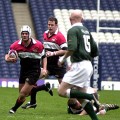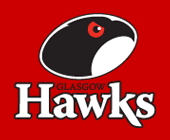|
SCOTLAND ON SUNDAY REPORTS
Philip backs himself to come back despite incessant frustrations
IAIN MORRISON
MY FIRST mistake is a bad one, asking Tom Philip how he is coping with life after rugby. The former Scotland centre struggles to hide his exasperation, wounded by the assumption that this most naturally-gifted midfielder of his generation is lost to the game.
"I think I will play again. There is no reason that I shouldn't play rugby again, although I know it will be hard to get back to where I was."
Where he was? At the centre of Matt Williams' plans for five consecutive Tests throughout the 2004 Six Nations Championship. While fellow Scotland debutantes Ally Hogg and Chris Cusiter have kicked ahead, Philip has been kicking his heels, laid low by injury.
A disastrous full-contact training session on the beach at Wellington did for his knee, but given that the rest of his body was held together with little more than elastic bands and sticky-back plastic, the ligament damage that day was just the straw that broke his back.
His back had been vulnerable for years, and since schoolboy days he had played suffering pain. He could no more side- step his shadow than he could rid himself of the constant hurt. Rugby players know pain, but this was different and more potent. Philip's crumbling vertebrae moved in too many dimensions, and were dangerously unstable: he was a teenager with a Saga spine.
Asked if he could remember a time when he played without pain, Philip mentions schoolboy stuff, but he quickly realises that the fractured vertebrae at the root of the problem were apparent even then. The injury was diagnosed when he was just 13, and he ignored all advice to rest.
As he grew older, the back got worse, and after his first international against Wales, he did not think that he would make it for his second. The back was so bad ahead of the Scotland tour to New Zealand and Australia in 2004 that he was unable to throw a Frisbee a week before he was supposed to face the Samoans in Wellington.
"People I did see about the injuries didn't really take it seriously, and that makes me pretty angry," Philip observes, "but I was my own worst enemy. I looked fit, and when the adrenaline got going, I was okay on the pitch, but I was still in a lot of pain. People just saw what I was doing, and presumed that if I was on the pitch, I was okay to play, so the whole thing must have been a mental issue. It wasn't, but I shouldn't have played all the times that I did."
Philip looks a picture of health once more, but again it is deceptive. He has just endured his fourth operation in the past two years, this time to remove titanium rods from his back that he has somehow managed to bend - presumably through sheer frustration as much as anything, because titanium is not supposed to bend. The rods were taken out in case they broke with catastrophic results, and his back remains raw from the surgery.
It was on Philip's initiative that the true nature of his back injury was eventually diagnosed. He took himself to Windsor where a surgeon recognised the double fracture for what it was, and fused two vertebrae. All this followed a double-hernia operation, which was supposed to heal his groin. It did not, and he admits that it was a low point in his struggle.
The man he turned to was Bill Taylor, the expert who originally diagnosed his back problem all those years ago. He still visits the physiotherapist, who has become a mentor to the young player. Philip trusts Taylor implicitly, and it is on his advice that he is pursuing his dream of playing the game again.
"Bill has said to me that he will always be honest, and if he thinks that it is all a waste of time, he will tell me so, and let me get on with my life. So far he says that there is no reason why I shouldn't play.
"When I did play for Scotland, I was nowhere near my full potential. I can be a lot better than I was back then, and that's one reason why I still want to make a comeback. I don't think that I'll ever be pain-free, but there are a lot of players who play with pain, and I'd be prepared to do it again."
Philip keeps busy, helping out at Edinburgh Academicals, where he occasionally coaches the amateur club and youngsters. He undertakes personal training in a gym, and has applied to join a course in journalism at Napier University.
Always keen on weight training, he now has nowhere else to release his pent-up energy and, despite taking it easy since his most recent surgery, even his biceps boast biceps. The player known as "Tank" has also adopted a keen interest in ultimate fighting. The sport is not governed by the Marquess of Queensberry, or by anyone else for that matter, and Philip's fascination suggests that beneath his quiet exterior the demons are still raging.
"I am not an aggressive guy, but rugby did allow me to get my frustrations out. I am being driven a little crazy."
Physiotherapist Taylor confirms that plenty athletes make comebacks at elite level following similar back injuries, but whether Philip will be one of them is impossible to say. If there is a trail out there that leads the young centre back to rugby, you have to hope that he finds it, because there is only one thing more painful for him than playing rugby: the altogether different sort of pain that he suffers from not participating.
This article was originally posted on 14-May-2006, 07:26 by Hugh Barrow.
Last updated by Hugh Barrow on 14-May-2006, 07:26.
|

Tom in action 2002 Cup Final
|









